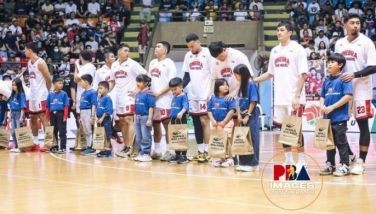Concern for the children
June 17, 2006 | 12:00am
There are two items that screamed for attention this week: the return to school of millions of children (probably groaning all the way), and the report that millions of children (most of whom don’t go to school) are engaged in child labor, often hazardous work.
These two seemingly opposite news stories come together in an often overlooked sector of society: child athletes. They go to school, and they’re also engaged in backbreaking labor, often endangering their health for the price of free tuition and a meal allowance every month.
Roy is thirteen years old. He wakes up at 5:30 a.m. every morning to walk to school, because the varsity team (he’s first-year high school), has practice before classes. Afterwards, he showers in the players’ quarters, then goes to class. By recess, he’s sleepy, and has trouble focusing on the class discussion. After school, he goes home, has lunch, takes a short nap, then goes back to school for their afternoon practice, which often runs from 4 to 8 p.m.
At night, Roy has learned to ice his aching knees, and occasionally take headache medicine. He tries not to cough in front of his parents when practice has been extra hard, for fear that they’ll make him take a day or two off. Anyway, he’s better off than his teammates, who have to cook their own food (whatever they can afford) and wash their own clothes in the dorm, before they can even think of doing their homework.
Not too many people realize how harsh high school and even some grade school coaches can be. Some coaches yell and scream at their players, thinking this will make them more efficient. At the same time, they deprive the boys of water as punishment or motivation, not believing reports that dehydration can do serious damage to a child’s health. Some even push boys as young as 12 to weigh train, including squats and military presses that could damage their fragile backs, impede their growth, and do permanent harm.
In the United States, certified athletic trainers and orthopedic surgeons have observed an alarming increase in adult-type athletic injuries among children and adolescents, mostly overuse injuries. According to the US Consumer Product Safety Commission, more than 3.5 million sports-related injuries in children under age 15 were treated in the US in 2003 alone. The US National Athletic Trainers’ Association and the American Academy of Orthopaedic Surgeons have launched an advertising campaign: "What will they have longer: their trophies or their injuries?"
What’s scary is that the same trend is being noticed by sports medicine practitioners in the Philippines, as well. Among them is Dr. Jose Raul Canlas, who runs the Philippine Center for Sports Medicine. Canlas, who represents the country among the medical boards of the IOC and FIBA, has expressed alarm over the growing incidence of overuse injuries like "jumper’s knee" even in children in Grade 6 and 7.
On top of all this, many athletic scholars are not really assisted in their studies, either. As long as they help the school they’re often given a free ride. But perhaps the worst part is that, since many kids don’t take kindergarten or grade seven, schools can have them repeat third and/or fourth year, just so they can serve the school longer, and perhaps be physically ripe for college. Some of these same kids have actually suited up for their high school teams as early as sixth grade. Think about it, college eligibility is a maximum of five years. In high school, you could even end up playing for seven. Imagine the damage to a kids’ knees and lower back.
Here are some of the common injuries caused by overuse:
Epiphyseal injuries. Sports that typically involve collision or falls produce fractures at the ends of the long bones, where growth plates are present and have not yet matured. Injury to this area of soft cartilage can also be found as a result of overuse, as one might see in a runner. Repetitive trauma can potentially lead to the growth plates hardening prematurely, resulting in stunted growth. Weight training can also be responsible for these fractures.
Sever’s Disease. This occurs at the base of the heel, where the Achilles tendon is attached, usually the result of excessive stress being placed on the bone’s vulnerable growth plate by the attached tendon. Jumping and sprinting are major causes.
Osgood-Schlatter’s Disease. This kind of knee injury is often linked to overuse, and is found in young football players. When the knee is being repeatedly extended (e.g. to kick a football), the patellar tendon is continually being pulled, and thus stress is placed on the tibia attachment. The damage in this area results in inflammation, pain, and the appearance of a bony lump.
Thrower’s elbow. Similar to ‘tennis elbow’, though it causes potentially more damage in children than adults. An overuse injury, with the muscles involved pulling on are relatively weak bones. It is common in throwers (e.g. of the javelin) and golfers.
Avulsion fractures. An avulsion is the tearing away of a body part from its point of attachment, thus an avulsion fracture occurs when a tendon that attaches a muscle to a bone pulls part of the bone away. Since children’s bones relatively weaker than their muscles and ligaments, it is the bone that gives way. This injury most often occurs in the pelvic area.
Spondylolysis. This back fracture tends to occur when excessive stress is placed on the spine, particularly if the sport requires hyperextension, like gymnastics or the butterfly stroke in swimming.
Heat Exhaustion or Heat Stroke, and Dehydration. Remember: children perspire less than adults, and require a higher core body temperature to trigger sweating. In its studies in the Philippines, the Gatorade Sports Science Institute has discovered that many athletes are already dehydrated even before they start working out.
The Department of Social Welfare and Development has strict rules about children being used in advertising, television and motion pictures. They must be accompanied by an adult, and have shorter working hours. Perhaps the DSWD should also look into the plight of child athletes, who may not realize the true danger of the stresses they place on their growing bodies.
These two seemingly opposite news stories come together in an often overlooked sector of society: child athletes. They go to school, and they’re also engaged in backbreaking labor, often endangering their health for the price of free tuition and a meal allowance every month.
Roy is thirteen years old. He wakes up at 5:30 a.m. every morning to walk to school, because the varsity team (he’s first-year high school), has practice before classes. Afterwards, he showers in the players’ quarters, then goes to class. By recess, he’s sleepy, and has trouble focusing on the class discussion. After school, he goes home, has lunch, takes a short nap, then goes back to school for their afternoon practice, which often runs from 4 to 8 p.m.
At night, Roy has learned to ice his aching knees, and occasionally take headache medicine. He tries not to cough in front of his parents when practice has been extra hard, for fear that they’ll make him take a day or two off. Anyway, he’s better off than his teammates, who have to cook their own food (whatever they can afford) and wash their own clothes in the dorm, before they can even think of doing their homework.
Not too many people realize how harsh high school and even some grade school coaches can be. Some coaches yell and scream at their players, thinking this will make them more efficient. At the same time, they deprive the boys of water as punishment or motivation, not believing reports that dehydration can do serious damage to a child’s health. Some even push boys as young as 12 to weigh train, including squats and military presses that could damage their fragile backs, impede their growth, and do permanent harm.
In the United States, certified athletic trainers and orthopedic surgeons have observed an alarming increase in adult-type athletic injuries among children and adolescents, mostly overuse injuries. According to the US Consumer Product Safety Commission, more than 3.5 million sports-related injuries in children under age 15 were treated in the US in 2003 alone. The US National Athletic Trainers’ Association and the American Academy of Orthopaedic Surgeons have launched an advertising campaign: "What will they have longer: their trophies or their injuries?"
What’s scary is that the same trend is being noticed by sports medicine practitioners in the Philippines, as well. Among them is Dr. Jose Raul Canlas, who runs the Philippine Center for Sports Medicine. Canlas, who represents the country among the medical boards of the IOC and FIBA, has expressed alarm over the growing incidence of overuse injuries like "jumper’s knee" even in children in Grade 6 and 7.
On top of all this, many athletic scholars are not really assisted in their studies, either. As long as they help the school they’re often given a free ride. But perhaps the worst part is that, since many kids don’t take kindergarten or grade seven, schools can have them repeat third and/or fourth year, just so they can serve the school longer, and perhaps be physically ripe for college. Some of these same kids have actually suited up for their high school teams as early as sixth grade. Think about it, college eligibility is a maximum of five years. In high school, you could even end up playing for seven. Imagine the damage to a kids’ knees and lower back.
Here are some of the common injuries caused by overuse:
Epiphyseal injuries. Sports that typically involve collision or falls produce fractures at the ends of the long bones, where growth plates are present and have not yet matured. Injury to this area of soft cartilage can also be found as a result of overuse, as one might see in a runner. Repetitive trauma can potentially lead to the growth plates hardening prematurely, resulting in stunted growth. Weight training can also be responsible for these fractures.
Sever’s Disease. This occurs at the base of the heel, where the Achilles tendon is attached, usually the result of excessive stress being placed on the bone’s vulnerable growth plate by the attached tendon. Jumping and sprinting are major causes.
Osgood-Schlatter’s Disease. This kind of knee injury is often linked to overuse, and is found in young football players. When the knee is being repeatedly extended (e.g. to kick a football), the patellar tendon is continually being pulled, and thus stress is placed on the tibia attachment. The damage in this area results in inflammation, pain, and the appearance of a bony lump.
Thrower’s elbow. Similar to ‘tennis elbow’, though it causes potentially more damage in children than adults. An overuse injury, with the muscles involved pulling on are relatively weak bones. It is common in throwers (e.g. of the javelin) and golfers.
Avulsion fractures. An avulsion is the tearing away of a body part from its point of attachment, thus an avulsion fracture occurs when a tendon that attaches a muscle to a bone pulls part of the bone away. Since children’s bones relatively weaker than their muscles and ligaments, it is the bone that gives way. This injury most often occurs in the pelvic area.
Spondylolysis. This back fracture tends to occur when excessive stress is placed on the spine, particularly if the sport requires hyperextension, like gymnastics or the butterfly stroke in swimming.
Heat Exhaustion or Heat Stroke, and Dehydration. Remember: children perspire less than adults, and require a higher core body temperature to trigger sweating. In its studies in the Philippines, the Gatorade Sports Science Institute has discovered that many athletes are already dehydrated even before they start working out.
The Department of Social Welfare and Development has strict rules about children being used in advertising, television and motion pictures. They must be accompanied by an adult, and have shorter working hours. Perhaps the DSWD should also look into the plight of child athletes, who may not realize the true danger of the stresses they place on their growing bodies.
BrandSpace Articles
<
>
- Latest
- Trending
Trending
Latest
Trending
Latest
Recommended































